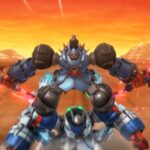
Mecha Profile: EF-2000 Typhoon – Muv-Luv Alternative
5 years after the BETA invasion, humanity finally reached the alien’s homeground – the Hive. However, that’s the extent that humanity could go. It’s clear that 1st-generation and 2nd-generation TSF aren’t going to cut it anymore. A drastic change in both engineering and combat doctrine is required if humanity want a chance against the BETA. With that in mind, the frontline nations – the European Union – came together to give birth to the storm that will sweep through Europe – the EF-2000 Typhoon.
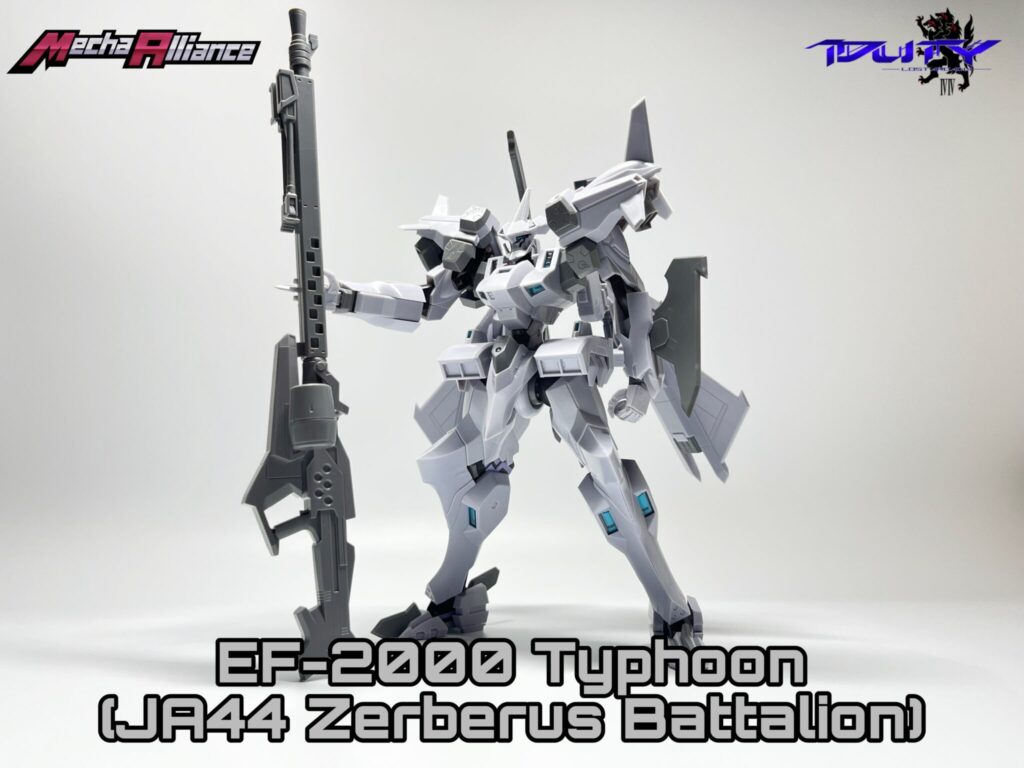
I. Development History:
– After Operation Palaiologos in 1978, the chance of the BETA’s westward invasion of Europe became certain. NATO member states including the United Kingdom, West Germany and France agreed to collaborate to develop a successor to Europe’s mainline TSF at the time – which were the F-5 variants – Mirage and Tornado. As such, in 1980, the European Combat Tactical Surface Fighter program (ECTSF) commenced.
– The ECTSF Program focused on the data learned from Op Palaiologos – which aims to focus on long distance invasion ability to breakthrough to a Hive, while also emphasizing mobility to dodge laser attacks and increased close-quarter capabilities for in-hive combat. As the Hive’s interior are closely packed with BETA and melee combat is a guaranteed 100% inside Hives. Coincidentally, those are also the US’ priorities in developing their F-15 Eagle – which were happening alongside the ECTSF Program. However, one critical difference between them is one of them were facing BETA attacks every day.
– Had the program went smoothly, it could have finished in 1985. However, with the increasing BETA aggression, and the withdrawal of France – one of the key members – from the program due to design disagreement, the program got hit with massive delays. Meanwhile, the F-15 was completed and deployed on the frontline. Subsequently, the UK essentially became the sole developer of the project, and they decided on an overhaul of the specifications. They aimed to produce not just a 2nd-generation craft, but a true 3rd-generation machine with even higher specs than initially drafted. In 1994, the prototype craft ESFP was built and displayed favorable results, and helped convince many countries to remain in the ECTSF program.
– Development progressed smoothly then. And in 1998, the advance mass production model, the EF-2000 Typhoon was deployed to trial combat groups. As of May 2000, the craft officially joined the frontline. One of the most prestigious groups of Typhoon pilot is the 44th Zerberus Tactical Armor Battalion – led by Wilfried von Aichberger, one of the Seven Heroes of Britain. The Typhoons can be seen deployed all over Europe, performing very well in the BETA war. In 2004, Japan imported a squadron of Typhoon for evaluation, with a possible mass-adoption, but the decision remain to be seen.
– After Operation Palaiologos in 1978, the chance of the BETA’s westward invasion of Europe became certain. NATO member states including the United Kingdom, West Germany and France agreed to collaborate to develop a successor to Europe’s mainline TSF at the time – which were the F-5 variants – Mirage and Tornado. As such, in 1980, the European Combat Tactical Surface Fighter program (ECTSF) commenced.
– The ECTSF Program focused on the data learned from Op Palaiologos – which aims to focus on long distance invasion ability to breakthrough to a Hive, while also emphasizing mobility to dodge laser attacks and increased close-quarter capabilities for in-hive combat. As the Hive’s interior are closely packed with BETA and melee combat is a guaranteed 100% inside Hives. Coincidentally, those are also the US’ priorities in developing their F-15 Eagle – which were happening alongside the ECTSF Program. However, one critical difference between them is one of them were facing BETA attacks every day.
– Had the program went smoothly, it could have finished in 1985. However, with the increasing BETA aggression, and the withdrawal of France – one of the key members – from the program due to design disagreement, the program got hit with massive delays. Meanwhile, the F-15 was completed and deployed on the frontline. Subsequently, the UK essentially became the sole developer of the project, and they decided on an overhaul of the specifications. They aimed to produce not just a 2nd-generation craft, but a true 3rd-generation machine with even higher specs than initially drafted. In 1994, the prototype craft ESFP was built and displayed favorable results, and helped convince many countries to remain in the ECTSF program.
– Development progressed smoothly then. And in 1998, the advance mass production model, the EF-2000 Typhoon was deployed to trial combat groups. As of May 2000, the craft officially joined the frontline. One of the most prestigious groups of Typhoon pilot is the 44th Zerberus Tactical Armor Battalion – led by Wilfried von Aichberger, one of the Seven Heroes of Britain. The Typhoons can be seen deployed all over Europe, performing very well in the BETA war. In 2004, Japan imported a squadron of Typhoon for evaluation, with a possible mass-adoption, but the decision remain to be seen.

II. Technical Specs & Armaments:
– The EF-2000 Typhoon is on the larger side of TSF, standing at 19.6-meter tall, utilizing two Aero Jet AJ200 engines. The Typhoon – just like other 3rd generation TSF – has a sleek profile and a heavy-top proportion to increase mobility during combat. In addition, more super carbon parts are included all over the design – such as the Jump Units. It was said that the Typhoon was developed with some technical assistance from Japan, but this has never been confirmed.
– The Typhoon 2000 is designed for combat on the European front with many vast plains and many hives (the BETA completely decimate and level the areas around Hives). Therefore, the Typhoon has high capability for dense, close quarters dogfighting in addition to its Hive capture ability. This is also shown by the amount of Super carbon blades throughout the craft – the head, shoulder blocks, knee armor, lower leg, tip of the feet and the heels. Not to mention two super large Super Carbon blades on the forearms that act as both melee weapon as well as support devices for aerodynamic control.
– For Assault Cannon, the Typhoon uses the GWS-9 Assault gun. The weapon is 20% lighter and smaller than its predecessor – the WS-16C. Its reliability is also improved. The weapon has elements from the G-36 and Enfield SA80 in real life.
– A unique ranged weapon that the Typhoon uses is the Mk.57 Squad Support Gun. Despite the name, the weapon is extremely powerful and much larger than the GWS-9. Replacing traditional armored artillery platform, the Mk.57 is the most versatile assault weapon for a TSF. Boasting a range of 20km, the Typhoon can offer long-range cover fire that tanks and artillery platforms could not. This gives the Typhoon firepower and the weapon mobility that land vehicles do not have, therefore enable the Typhoon to offer support fire to other TSFs.
– For melee weapon, the Typhoon uses the BWS-8 Flugelberte, developed by the Federal Republic of Germany. The weapon resembles a streamlined ax and is top-heavy enough to give it powerful striking power for a one-handed weapon. The craft does not have close-quarter combat dagger but rather use the forearm blades instead. The Typhoon also uses the DS-3 Multi-Purpose Supplemental Armor used by all European forces since the start of the BETA war.
– Another rarely seen and extremely unique weapon is the BWS-3 Great Sword. It is a huge two-handed sword only wielded by Storm Vanguards and the best of the best in TSF piloting. The weapon is famously nicknamed the “Fort Slayer”, with incredible penetrating power powerful enough to pierce through the Fort Class and their limbs. Developed by the British, this weapon is a signature of skill used by veteran Surface Pilots.
III. Gallery:




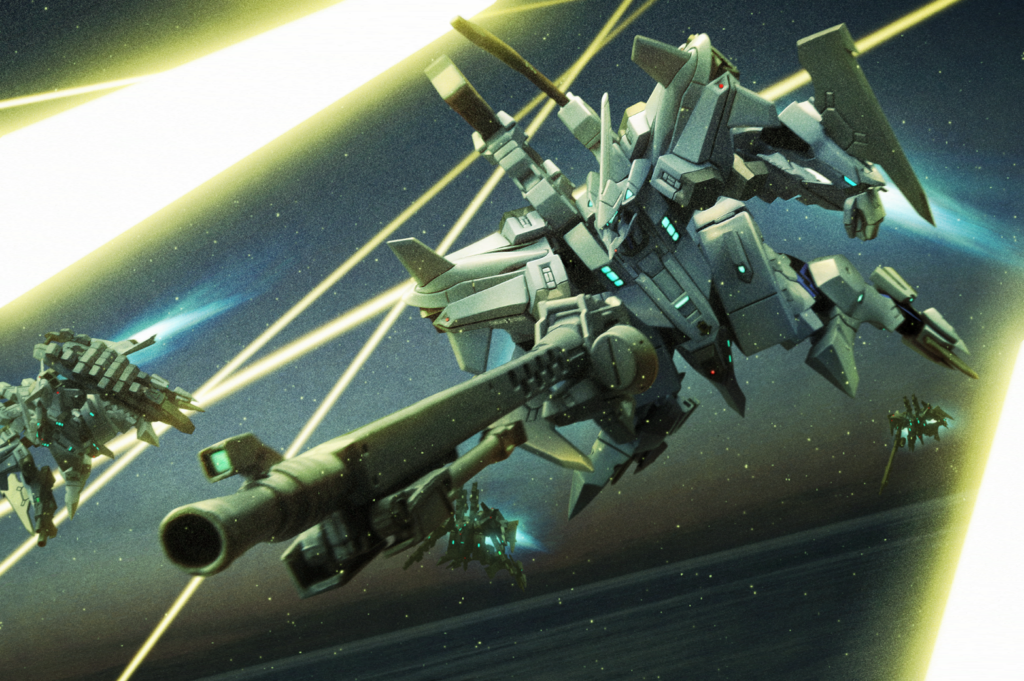

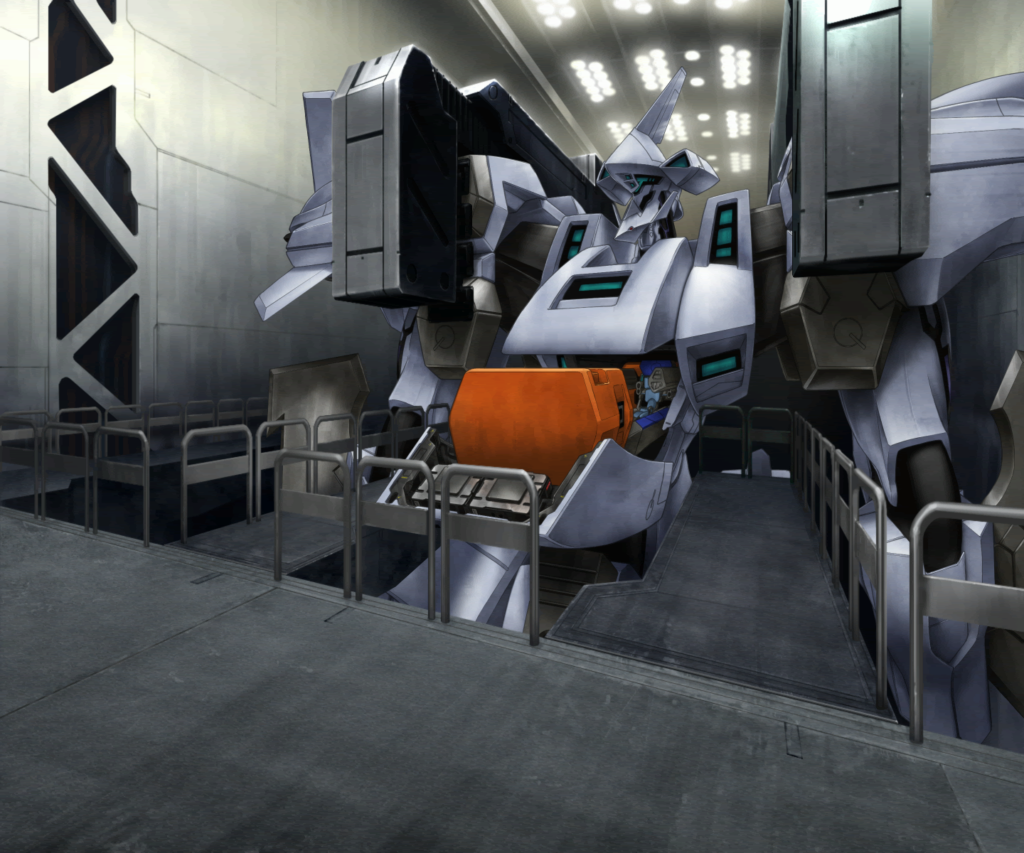



IV. Trivia:
– The Typhoon has only one version, but there are many different color depends on squadron. Their performance are pretty much the same. The mass-production color is slight grey. However we also have:
> Black: Alfried von Aichberger‘s personal unit. One of the Seven Heroes of Britain and Leader of the Zerberus Battalion.
> White: Sigelinde von Fahrenhorst‘s personal unit. One of the Seven Heroes of Britain and number 2 of the Zerberus Battalion.
> Crimson Red: Gerhard von Wallerstein‘s personal unit. One of the Seven Heroes of Britain and Captain of the Rote squadron of the Zerberus Battalion.
> Blue: Duon Strumgeist‘s personal unit. One of the Seven Heroes of Britain and Captain of the Blau squadron of the Zerberus Battalion.
– The Typhoon has only one version, but there are many different color depends on squadron. Their performance are pretty much the same. The mass-production color is slight grey. However we also have:
> Black: Alfried von Aichberger‘s personal unit. One of the Seven Heroes of Britain and Leader of the Zerberus Battalion.
> White: Sigelinde von Fahrenhorst‘s personal unit. One of the Seven Heroes of Britain and number 2 of the Zerberus Battalion.
> Crimson Red: Gerhard von Wallerstein‘s personal unit. One of the Seven Heroes of Britain and Captain of the Rote squadron of the Zerberus Battalion.
> Blue: Duon Strumgeist‘s personal unit. One of the Seven Heroes of Britain and Captain of the Blau squadron of the Zerberus Battalion.
Swipe for more:

Mecha Profile: Gundam ZZ – Qubeley
A machine fitting for the queen of Neo Zeon. The Qubeley is a special machine made for a special pilot. Its funnel dominate the battlefield.

Mecha Profile: Gundam ZZ – ZZ Gundam
Power overwhelming! One of the main Gundam with the highest firepower pre CCA. The ZZ Gundam is an all-in-one combiner that was pivotal in the war against the Neo Zeon.

Mecha Profile: Gundam 0079 – MS-06 Zaku II
The backbone of the Principality of Zeon in the One Year War. The Zaku is not a super prototype, but its reliable performance has brought Zeon many victories – especially when Char Aznable pilot it.

Mecha Profile: MS Gundam Zeta – PMX-003 The O
One of the most chonky bois to ever appear on screen. Piloted by the nefarious Scirocco, The-O is an impressive MS that is more agile than it looks.

Mecha Profile: Gundam Age – Gundam AGE-FX
The ultimate evolution of the Age Gundams. The Age-FX can bring an X-Rounder’s ability to their maximum potential, featuring funnels that can wipe out fleets of enemy.

Mecha Profile: MS Gundam Zeta – MSZ-006 Zeta Gundam
The first transformable Gundam in the franchise. The Zeta Gundam is an iconic mobile suit that paved the way for many Gundams that come after.

Mecha Profile: Gundam Age – Gundam AGE-3
Another change in generation – the Age-3 Gundam continues to be the Asuno family’s ace in the hole, sporting all new gimmick and superior firepower.

Mecha Profile: Gundam 0079 – RX-78-2 Gundam
The grandfather of all Gundams – the RX078-2 is a super prototype that paved the way for the Federation’s victory. It is both feared and revered by all.

Mecha Profile: Gundam Age – Gundam AGE-2
The 2nd generation Gundam, the Age-2 is a straight upgrade with a heavy focus on high mobility and great firepower. A vital element in the war between the Federation and the Vagan.

Mecha Profile: Gundam Age – Gundam AGE-1
The first generation Gundam of the Advance Generation, the Age-1 Gundam is Flit Asuno’s most trusted partner and has served him for decades.

Mecha Profile: Aquarion Mars – Sousei no Aquarion
The swordsman of power – Aquarion Mars is the 3rd form of the triple-changer super robot. It is an elegant and agile knight excel in close combat using its sword.

Mecha Profile: Aquarion Luna – Sousei no Aquarion
Armed with the bow and arrow of the Moon, the Luna Aquarion is the 2nd form of the Mechanical Angel, focusing on ranged attack with deadly precision and elegance.

Mecha Profile: Solar Aquarion – Sousei no Aquarion
The shining wings of the Sun – the Solar Aquarion is a mechanical angel that stood on humanity’s side. Its infinite fist can reach the sky and..well…literally anything.

Mecha Profile: Megaton-Class Rogue Musashi-O – Megaton-kyuu Musashi
A twin unit of the Musashi, the Musashi-O is an experienced combat machine that helped Arshem to achieve her goal. A Megaton-class with a Megaton sass.

Mecha Profile: Megaton-Class Rogue Sparkman/Sparkman Wave – Megaton-kyuu Musashi
Carrying the weight of both worlds in his arms, Teru set out to protect the world where his loved one lives. He heads to battle in an electrifying Megaton-class: the Sparkman.

Mecha Profile: Megaton-Class Rogue Gaudia/Gaudia Armored – Megaton-kyuu Musashi
Power overwhelming. The tanky brawler from the hood is here to protect! Ryugo Hijikata – a rough but kind-hearted boy – pilot his Megaton-class into battle – the Gaudia.

Mecha Profile: Megaton-Class Rogue Musashi X – Megaton-kyuu Musashi
The ultimate Megaton-class – the Musashi X. The final hope of humanity sees the reunion of the original trio – Yamato, Teru and Ryuugo for the final battle.

Mecha Profile: Megaton-Class Rogue Maximus – Megaton-kyuu Musashi
After the all-rounder and the galloping Rogue, next is the bulky Gladiator. The Maximus is a one-Rogue-army capable of clearing the battlefield in just one attack.

Mecha Profile: Megaton-Class Rogue Arthur – Megaton-kyuu Musashi
The white knight is here! And he is one with his horse. The Megaton-class Arthur is a quadruple Rogue with the ability to channel extremely powerful psychic energy.

Mecha Profile: Megaton-Class Rogue Musashi – Megaton-kyuu Musashi
A giant robot that is the hope of humanity. The Megaton-class Musashi is the titular robot with a unique fighting style and extremely powerful abilities.

Mecha Profile: Fafner Mark Alles – Soukyuu no Fafner: The Beyond
A man who has sacrificed all that he is – has now gained the power of Everything. The Fafner Mark Alles is Kazuki’s ultimate machine with immeasurable power.

Mecha Profile: Fafner Mark Raison – Soukyuu no Fafner: The Beyond
A denier of ‘reason’ – the Mark Raison encompasses the Festum’s desire to comprehend and assimilate human. The 3rd Salvator model that bring calamity.

Mecha Profile: Fafner Mark Funf Kai “Tsukuyomi” – Soukyuu no Fafner: Exodus
A tenacious shield of the Island, Mimika Mikagami inherited the mantle of the Kidou Samurai Goubain and withit the Fafner Mark Funf Kai Tsukuyomi.

Mecha Profile: Fafner Mark Sech Kai “Amaterasu” – Soukyuu no Fafner: Exodus
A brilliant strategist plus an agile warrior with an entire armory in his hands, Sui Kaburagi and the Amaterasu prove they are a man-machine army!

Mecha Profile: Fafner Mark Elf Kai “Susanoo” – Soukyuu no Fafner: Exodus
The pinnacle of martial might and discipline. The Mark Elf was rebuilt and assigned to the best swordman on the Island – Reo Mikado. Holding the title of Susanoo, the Mark Elf’s sword can reach any target.

Mecha Profile: Fafner Mark DreiZehn Kai “Chronos” – Soukyuu no Fafner: The Beyond
A machine inherited from the future – the Mark DreiZehn lost its original master and gain another surprising pilot. Kurusu Misao – a Festum – took over the clairvoyant Fafner.

Mecha Profile: Fafner Mark Zwei Kai “Grimreaper” – Soukyuu no Fafner: The Beyond
An old machine given life by the strongest pilot. The Mark Zwei reappear on the battlefield as a fearsome power that can render all ineffective – a Grimreaper.

Mecha Profile: Fafner Mark Ein Kai “Specter” – Soukyuu no Fafner: The Beyond
A ghost from the past returned to interfere with the future. A stolen Fafner unit now fell into the hands of the hostile Festum and stood in the way of hope – the Mark Ein Kai.

Mecha Profile: AHSMB Black Six – Ginga Kikoutai Majestic Prince
The black sheep – I meant Black Six has entered the fray. A Multi-role unit that can fight in any circumstances and any position, with an aggressive pilot that can utilize the unit’s impressive array of weapons.
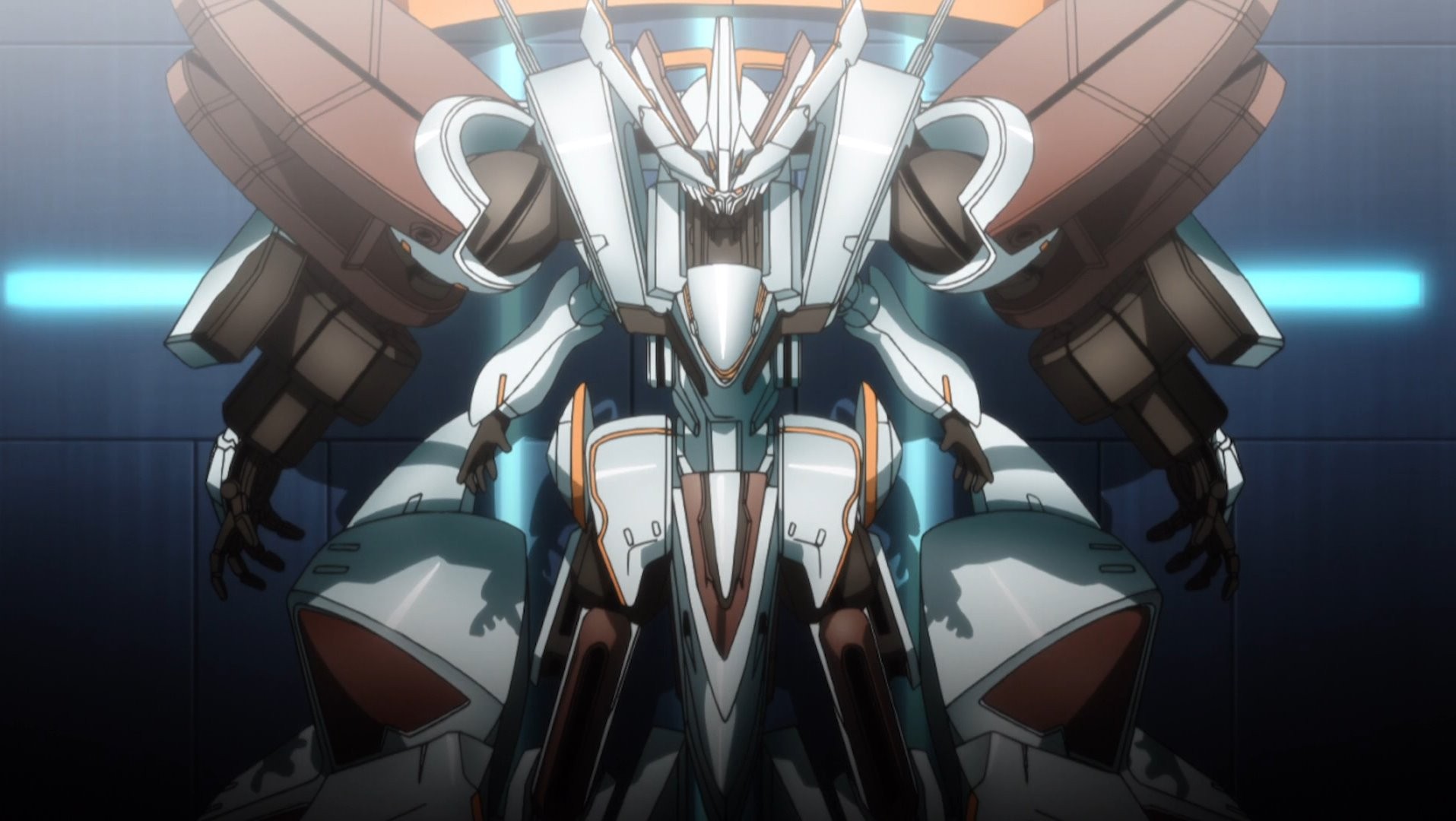
Mecha Profile: AHSMB White Zero – Ginga Kikoutai Majestic Prince
Power, Speed and Fortitude. The Rose Three is the most massive, yet fastest unit of Team Rabbit, and can disrupt the enemy’s formation by boosting itself through the battlefield.

Mecha Profile: Fafner Mark DreiZehn – Soukyuu no Fafner: Dead Aggressor
Embrace the past and change the future! The Fafner Mark DreiZehn is specifically constructed for Canon Memphis – the one that gave hope to Tatsumiyajima.

Mecha Profile: AHSMB Gold Four – Ginga Kikoutai Majestic Prince
There are no target he cannot reach! The artillery and weapon fanatic of Team Rabbit, Suruga pilot a literal weapon platform that dealt many victory shots: the Gold Four.

Mecha Profile: AHSMB Purple Two – Ginga Kikoutai Majestic Prince
The brains of the operation – the Purple Two is a strategic analysis unit that is vital to Team Rabbit’s success. And it can fight too!
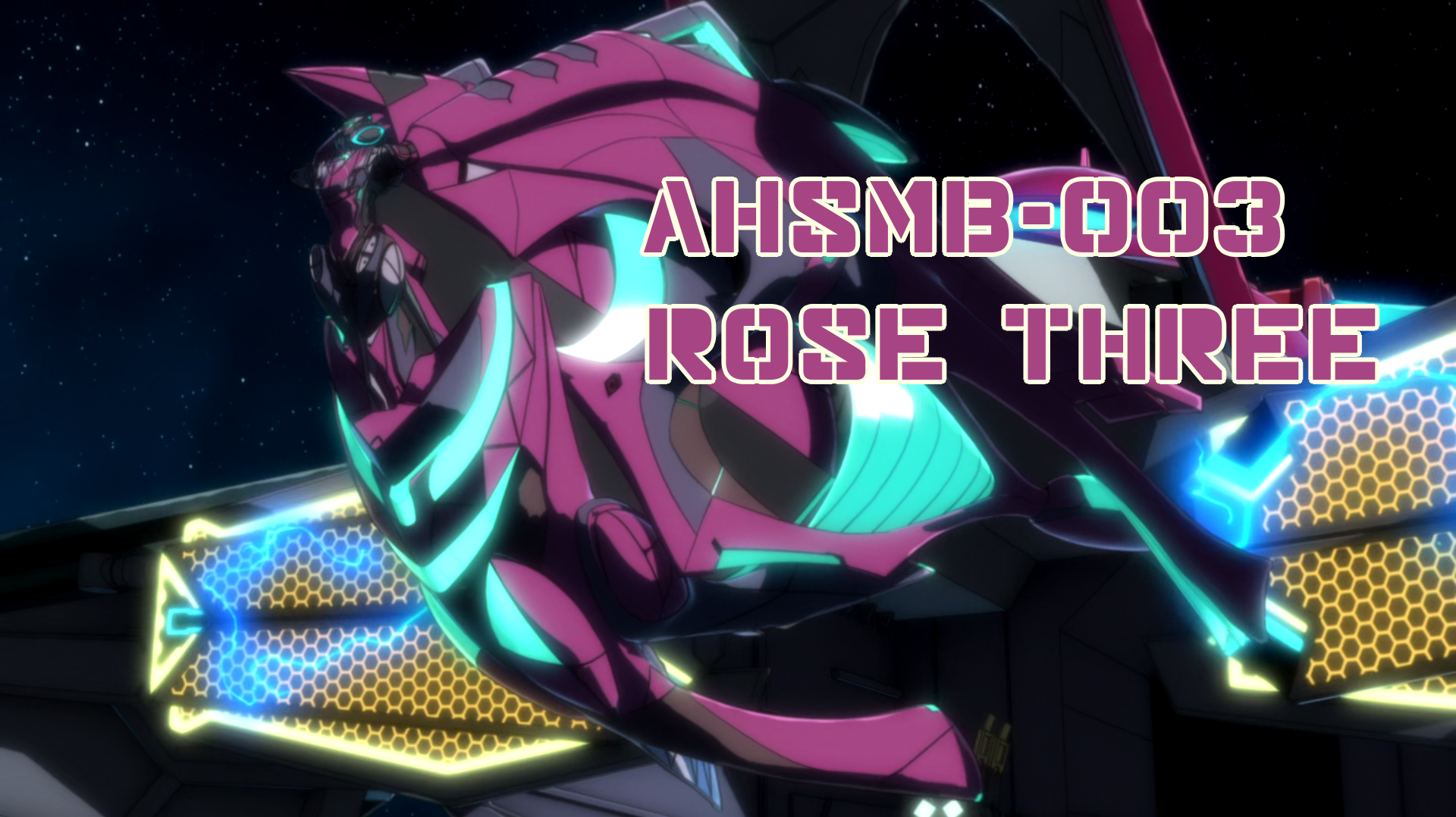
Mecha Profile: AHSMB Rose Three – Ginga Kikoutai Majestic Prince
Power, Speed and Fortitude. The Rose Three is the most massive, yet fastest unit of Team Rabbit, and can disrupt the enemy’s formation by boosting itself through the battlefield.
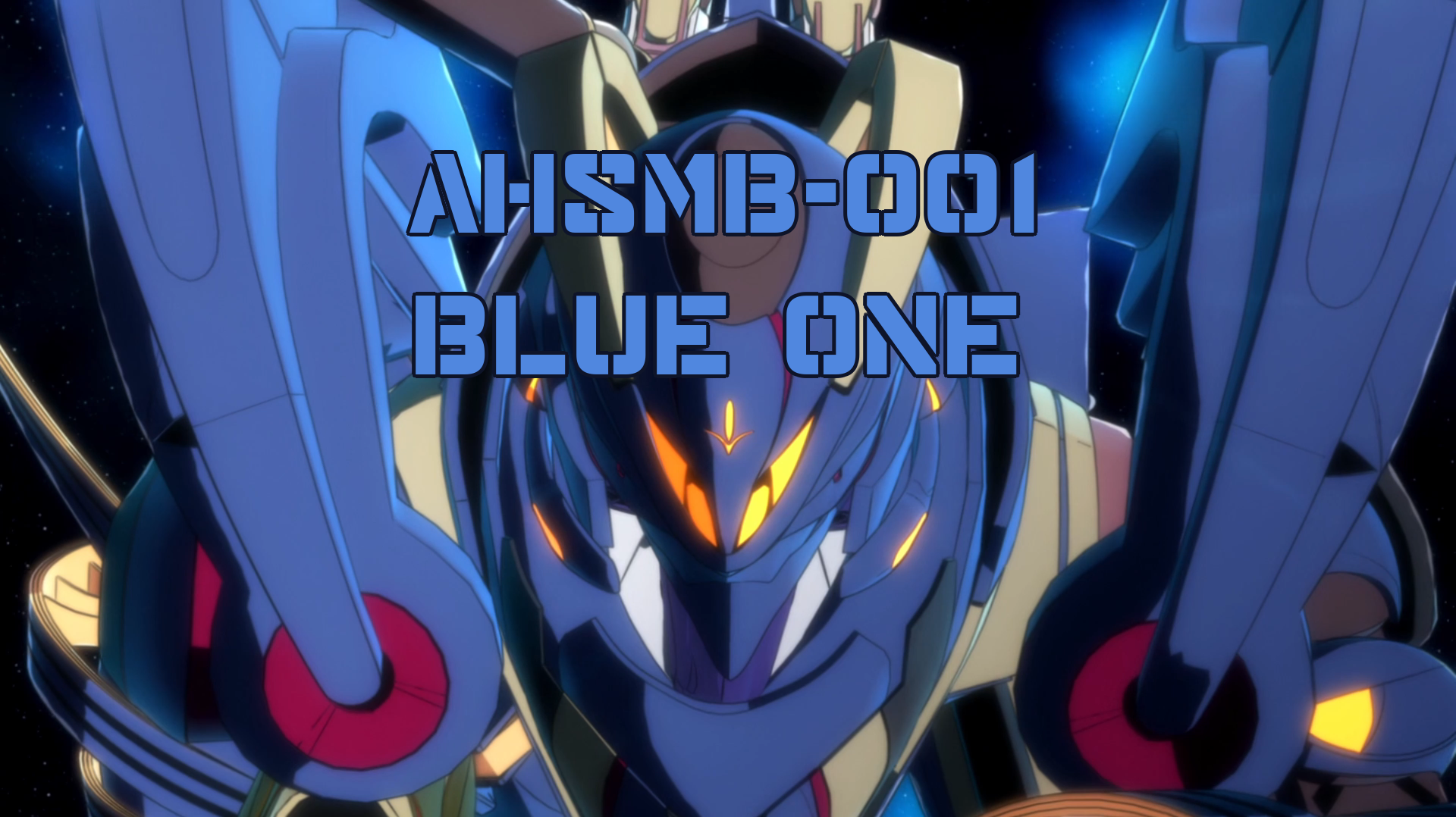
Mecha Profile: AHSMB Blue One – Ginga Kikoutai Majestic Prince
The logical pillar of support for Team Rabbit as well as Izuru – Asagi take the secondary vanguard position with the first AHSMB – The Blue One.

Mecha Profile: AHSMB Red Five – Ginga Kikoutai Majestic Prince
The hero unit of Team Rabbit – the Red Five is the forward leader and the only unit able to stand toe-to-toe the strongest Wulgaru generals.

Mecha Profile: Fafner Mark Nicht – Soukyuu no Fafner: Dead Aggressor
The other side of Existence – Nothingness. A void born out of hatred, but used to give Hope. The Fafner Mk Nicht is the Yin Salvator Model that complement the Yang – Mark Sein.

Mecha Profile: Rafale – Muv-Luv Alternative
France proved they are capable of building a TSF of their own. A simplification of advance TSF technologies that result in an all-rounder 3rd-gen craft: the Rafale.

Mecha Profile: Fafner Mark Zwolf – Soukyuu no Fafner: Dead Aggressor
The literal spearhead unit – the Fafner Mk. Zwolf goes into battle with a unique weapon and an appetite to consume the Festum unlike any others!

Mecha Profile: Fafner Mark Sein – Soukyuu no Fafner: Dead Aggressor
One of the first two Salvator models – the Mark Sein grants Kazuki an incredible blessing – the strongest assimilation ability of any Fafner. The existence of the Mark Sein marks the turning point of Fafner’s world.

Mecha Profile: EF-2000 Typhoon – Muv-Luv Alternative
Europe’s most widely used 3rd generation Tactical Surface Fighters. The Typhoon’s high performance and unique weapon set sweep through the BETA on the frontline.

Mecha Profile: Fafner Mark Zehn – Soukyuu no Fafner: Dead Aggressor
A Fafner unit piloted by the 2nd Nishio twin Akira. The Mark Zehn is focused on long-range sniping just like the Sieben – whose pilot Akira looks up to.

Mecha Profile: Fafner Mark Neun – Soukyuu no Fafner: Dead Aggressor
A Nothung-model piloted by one of the Nishio twins, the Mark Neun is focused on defensive ranged combat with a unique weapon of its own.

Mecha Profile: Mirage 2000 – Muv-Luv Alternative
Unsatisfied with the Freedom Fighter that the U.S provided, the French manufacturer Dass-Ault knew they had to improve the unit for their people. And the Mirage 2000 was born.

Mecha Profile: Fafner Mark Vier – Soukyuu no Fafner: Dead Aggressor
The prodigal son of D-Island. Always coming to the Island’s help in time of need, a formidable warrior with a heart of gold: Kouyou and his Fafner Mark Vier.

